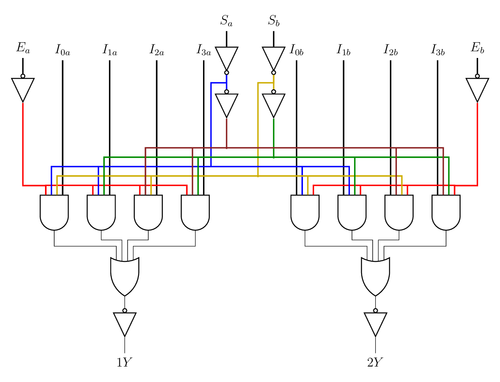This image was taken from a handbook about TTL Logic devices.

Edit and compile if you like:
% Block Diagram for TTL IC Multiplexer 74HC153
% Author: Ramón Jaramillo.
\documentclass[tikz,border=10pt,12pt,x11names]{standalone}
\usepackage{tikz}
\usetikzlibrary{circuits.logic.US} % TiKZ Library for US Logic Circuits.
\begin{document}
\begin{tikzpicture}[circuit logic US, every circuit symbol/.style={thick}]
% Logic Gates in Left Side of Multiplexor
\node[buffer gate, point down,inputs={i}] (buf1) at (-1,3) {}; % Input Ea
\node[and gate,inputs={nnnn}, point down] (and1) at (0,-1) {};
\node[and gate,inputs={nnnn}, point down] (and2) at (1.5,-1) {};
\node[and gate,inputs={nnnn}, point down] (and3) at (3,-1) {};
\node[and gate,inputs={nnnn}, point down] (and4) at (4.5,-1) {};
\node[or gate,inputs={nnnn}, point down] (or1) at (2.25,-3) {};
\node[not gate, point down] (not1) at (5.5,4) {}; % Input Sa
\node[buffer gate, point down,inputs={i}] (buf2) at (5.5,2.5) {};
% Left Side connections
\draw [red, very thick] (buf1.output) -- ++(down:26.4mm) -| (and1.input 4);
\draw (and1.output) -- ++(down:5mm) -| (or1.input 4);
\draw (and2.output) -- ++(down:3mm) -| (or1.input 3);
\draw (and3.output) -- ++(down:3mm) -| (or1.input 2);
\draw (and4.output) -- ++(down:5mm) -| (or1.input 1);
\draw (not1.output) -- (buf2.input);
% Logic Gates in Right Side of Multiplexor
\node[not gate, point down] (not2) at (7,4) {}; % Input Sb
\node[buffer gate, point down,inputs={i}] (buf3) at (7,2.5) {};
\node[buffer gate, point down,inputs={i}] (buf4) at (13.50,3) {}; % Input Eb
\node[and gate,inputs={nnnn}, point down] (and5) at (8,-1) {};
\node[and gate,inputs={nnnn}, point down] (and6) at (9.5,-1) {};
\node[and gate,inputs={nnnn}, point down] (and7) at (11,-1) {};
\node[and gate,inputs={nnnn}, point down] (and8) at (12.5,-1) {};
\node[or gate,inputs={nnnn}, point down] (or2) at (10.25,-3) {};
\draw (not2.output) -- (buf3.input);
% Right Side connections
\draw [red, very thick] (buf4.output) -- ++(down:26.4mm) -| (and8.input 1);
\draw (and5.output) -- ++(down:5mm) -| (or2.input 4);
\draw (and6.output) -- ++(down:3mm) -| (or2.input 3);
\draw (and7.output) -- ++(down:3mm) -| (or2.input 2);
\draw (and8.output) -- ++(down:5mm) -| (or2.input 1);
% Inputs and Outputs of Multiplexer
\draw [black,very thick] (buf1.input) -- ++(up:5mm) node [above]{$E_a$};
% Enable Signal a
\draw [black,very thick] (buf4.input) -- ++(up:5mm) node [above]{$E_b$};
% Enable Signal b
\draw [black,very thick] (not1.input) -- ++(up:5mm) node [above]{$S_a$};
% Selection Signal a
\draw [black,very thick] (not2.input) -- ++(up:5mm) node [above]{$S_b$};
% Selection Signal b
% Inputs I_na with n={0, 1, 2, 3}
\draw [black,very thick] (and1.input 1) -- ++(up:4.3) node [above]{$I_{0a}$};
\draw [black,very thick] (and2.input 1) -- ++(up:4.3) node [above]{$I_{1a}$};
\draw [black,very thick] (and3.input 1) -- ++(up:4.3) node [above]{$I_{2a}$};
\draw [black,very thick] (and4.input 1) -- ++(up:4.3) node [above]{$I_{3a}$};
% Inputs I_nb with n={0, 1, 2, 3}
\draw [black,very thick] (and5.input 4) -- ++(up:4.3) node [above]{$I_{0b}$};
\draw [black,very thick] (and6.input 4) -- ++(up:4.3) node [above]{$I_{1b}$};
\draw [black,very thick] (and7.input 4) -- ++(up:4.3) node [above]{$I_{2b}$};
\draw [black,very thick] (and8.input 4) -- ++(up:4.3) node [above]{$I_{3b}$};
% Output of NOT gates
\draw [blue, very thick] (not1.output) -- ++(down:2.5mm)
-- ++(left:5mm) -- (5,0.45);
\draw [blue, very thick] (not1.output) -- (buf2.input);
\draw [Gold3, very thick] (not2.output) -- ++(down:2.5mm) -- ++(left:5mm)
-- (6.5,0.1);
\draw [Gold3, very thick] (not2.output) -- (buf3.input);
% Output of BUFFER gates
\draw [Brown4, very thick] (buf2.output) -- (5.5,1);
\draw [Green4, very thick] (buf3.output) -- (7,0.7);
% Interconnection of AND gates
\draw [red,very thick] (and1.input 4) -- ++(up:3mm) -| (and2.input 4)
-- ++(up:3mm) -| (and3.input 4) -- ++(up:3mm) -| (and4.input 4);
\draw [red,very thick] (and5.input 1) -- ++(up:3mm) -| (and6.input 1)
-- ++(up:3mm) -| (and7.input 1) -- ++(up:3mm) -| (and8.input 1);
\draw [blue,very thick] (and1.input 3) -- ++(up:9mm) -| (and2.input 3)
-- ++(up:9mm) -| (and5.input 3) -- ++(up:9mm) -| (and6.input 3);
\draw [Gold3,very thick] (and1.input 2) -- ++(up:6mm) -| (and3.input 2)
-- ++(up:6mm) -| (and5.input 2) -- ++(up:6mm) -| (and7.input 2);
\draw [Green4,very thick] (and2.input 2) -- ++(up:12mm) -| (and4.input 2)
-- ++(up:12mm) -| (and6.input 2) -- ++(up:12mm) -| (and8.input 2);
\draw [Brown4,very thick] (and3.input 3) -- ++(up:15mm) -| (and4.input 3)
-- ++(up:15mm) -| (and7.input 3) -- ++(up:15mm) -| (and8.input 3);
% Outputs of multiplexer
% Buffers at output of OR logic gates.
\node[buffer gate, point down,inputs={i}] (1y) at (2.25,-4.5) {};
\node[buffer gate, point down,inputs={i}] (2y) at (10.25,-4.5) {};
% Connecting output of OR logic gates to Buffers input
\draw (or1.output) -- (1y.input);
\draw (or2.output) -- (2y.input);
% Outputs of multiplexer
\draw (1y.output) -- ++(down:5mm) node [below]{$1Y$};
\draw (2y.output) -- ++(down:5mm) node [below]{$2Y$};
\end{tikzpicture}
\end{document}Click to download: multiplexer.tex • multiplexer.pdf
Open in Overleaf: multiplexer.tex

